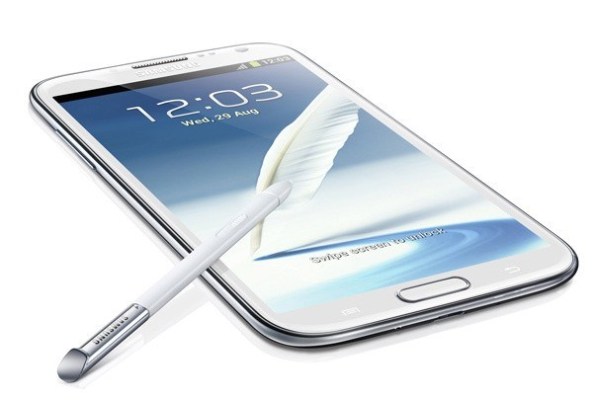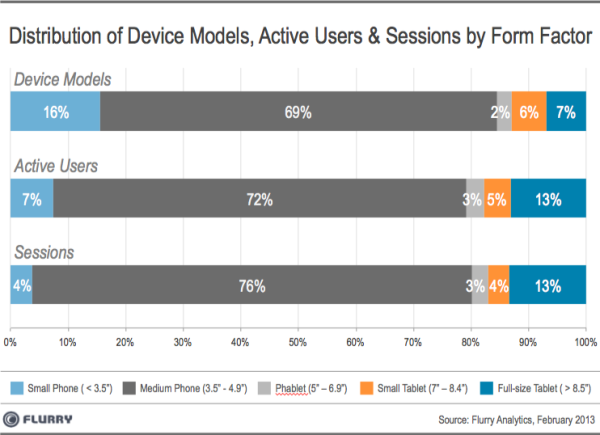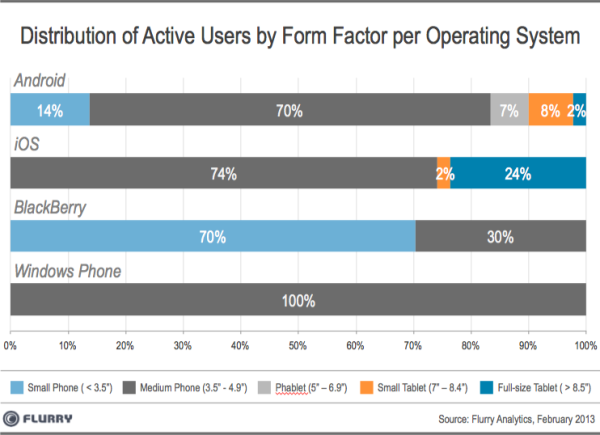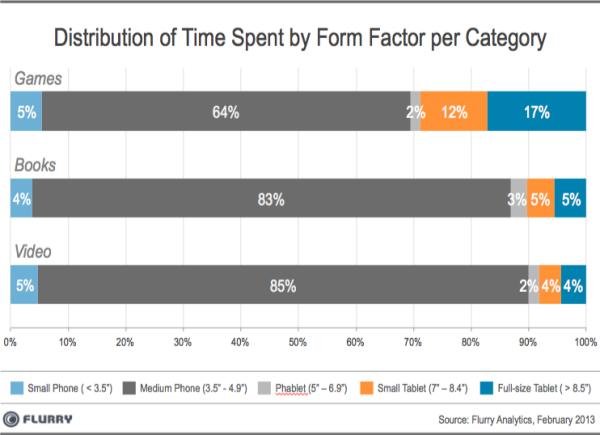Flurry, an app analytics firm with a presence on some now 1 billion mobile devices, has taken another deep dive into its large data set to examine the increasingly fragmented selection of hardware form factors on the market today, in an effort to better understand consumer preferences. The report concludes that people most prefer and use apps on medium-sized smartphones, like those in the Samsung Galaxy line, and full-sized tablets like the iPad. “Phablets,” meanwhile, Flurry dubs a “fad,” saying that they don’t show significant, or even disproportionally significant, app usage.
To reach these conclusions, Flurry’s report looked at the top 200 device models in its database, which represent over 80 percent of all usage. It then broke down the devices into the following five groups:
1. Small phones (e.g., most Blackberries), 3.5” or under screens
2. Medium phones (e.g., iPhone), between 3.5” – 4.9” screens
3. Phablets (e.g., Galaxy Note), 5.0” – 6.9” screens
4. Small Tablets (e.g., Kindle Fire), 7.0” – 8.4” screens
5. Full-size tablets (e.g., the iPad), 8.5” or greater screens
You can see the distribution of these devices in the chart below – e.g., 16 percent have screen sizes 3.5 inches or smaller (in diagonal length); 69 percent are 3.5 to 4.9 inches – a large group which includes the iPhone; 6 percent are small tablets like the Kindle Fire and iPad mini; 7 percent are full-sized tablets like the iPad. Meanwhile, just 2 percent of devices are “phablets.”
But as you may already know, device distribution doesn’t always equate to how those platforms are actually being used by consumers. Android users, for example, despite the platform’s dominant global market share, show less engagement than iOS users overall, and watch less video.
So Flurry compared the device install base with the number of active users and app sessions. The conclusions support the trends we’ve been hearing about for some time. For instance, even though small-screened devices account for 16 percent of devices in the market, only 7 percent are “active devices,” once users per device are taken into account, and only represent 4 percent of overall app sessions.
For tablets, however, it’s the opposite – despite their small market share (7 percent of the top 200), they represent 15 percent of active users and 13 percent of active sessions.
Flurry says this is because on the small end, users are on older phones, like Blackberry models, so there are fewer active users per model. These small devices are also obviously not ideal for running and using apps. And tablets, of course, are.
However, on the in-between screen sizes known as “phablets,” their install base is 2 percent, while active users and sessions is just 3 percent. “Phablets are a fad,” proclaims Flurry in its post about this finding.
The OS-specific data is fairly obvious. Medium-sized phones are the dominant form factor across all operating systems except Blackberry, the report also notes. Android dominantes the “phablet” market, while iOS dominates large tablets. The only Windows Phone devices in the top 200 are medium-sized phones.
What is interesting is are the app trends across form factors. “Tablets are gaming machines,” says Flurry, noting that a third of time spent gaming now takes place on larger tablets like the iPad, as well as small tablets and phablets. “And while they command consumer time spent, they represented only 15% of device models in use in February and 21% of individual connected devices. These differences are statistically significant,” the post notes.
And oddly enough, despite the tablets’ larger screens, they don’t see a larger portion of time spent in the books and video categories. Flurry speculates that’s because consumers are consuming a lot of text and video on their smartphones already.
The report concludes that developers concentrate their efforts on medium-sized devices and tablets, not phablets and other small-screened phones.



